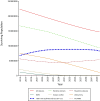The Socioeconomic Burden of Pain From War
- PMID: 30495989
- PMCID: PMC6301420
- DOI: 10.2105/AJPH.2018.304744
The Socioeconomic Burden of Pain From War
Abstract
War's burden on the health and well-being of combatants, civilians, and societies is well documented. Although the examination of soldiers' injuries in modern combat is both detailed and comprehensive, less is known about war-related injuries to civilians and refugees, including victims of torture. The societal burden of war-related disabilities persists for decades in war's aftermath. The complex injuries of combat survivors, including multiple pain conditions and neuropsychiatric comorbidities, challenge health care systems to reorganize care to meet these survivors' special needs.We use the case study method to illustrate the change in pain management strategies for injured combat survivors in one national health system, the US Department of Veterans Affairs (VA). The care of veterans' disabling injuries suffered in Vietnam contrasts with the care resulting from the VA's congressional mandate to design and implement a pain management policy that provides effective pain management to veterans injured in the recent Middle East conflicts.The outcomes-driven, patient-centric Stepped Care Model of biopsychosocial pain management requires system-wide patient education, clinician training, social networking, and administrative monitoring. Societies are encouraged to develop their health care system's capacity to effectively respond to the victims of warfare, including combatants and refugees.
Figures


Similar articles
-
A population approach to mitigating the long-term health effects of combat deployments.Prev Chronic Dis. 2012;9:E54. doi: 10.5888/pcd9.110116. Epub 2012 Feb 9. Prev Chronic Dis. 2012. PMID: 22321146 Free PMC article.
-
Bilateral transfemoral/transtibial amputations due to battle injuries: a comparison of Vietnam veterans with Iraq and Afghanistan servicemembers.Clin Orthop Relat Res. 2014 Oct;472(10):3010-6. doi: 10.1007/s11999-014-3534-9. Clin Orthop Relat Res. 2014. PMID: 24585323 Free PMC article.
-
Long-Term Health Care Costs for Service Members Injured in Iraq and Afghanistan.Mil Med. 2023 Jul 22;188(7-8):e2431-e2438. doi: 10.1093/milmed/usad008. Mil Med. 2023. PMID: 36734126
-
Suicide risk and prevention in veteran populations.Ann N Y Acad Sci. 2010 Oct;1208:98-103. doi: 10.1111/j.1749-6632.2010.05697.x. Ann N Y Acad Sci. 2010. PMID: 20955331 Review.
-
Adapting the multifamily group model for treating veterans with posttraumatic stress disorder.Psychol Serv. 2012 Nov;9(4):349-60. doi: 10.1037/a0028963. Epub 2012 Jun 25. Psychol Serv. 2012. PMID: 22731838 Review.
Cited by
-
Chronic pain diagnosis in refugee torture survivors: A prospective, blinded diagnostic accuracy study.PLoS Med. 2020 Jun 5;17(6):e1003108. doi: 10.1371/journal.pmed.1003108. eCollection 2020 Jun. PLoS Med. 2020. PMID: 32502219 Free PMC article.
-
Pain Care in the Department of Veterans Affairs: Understanding How a Cultural Shift in Pain Care Impacts Provider Decisions and Collaboration.Pain Med. 2020 May 1;21(5):970-977. doi: 10.1093/pm/pnz341. Pain Med. 2020. PMID: 31886869 Free PMC article.
References
-
- Gallagher RM. Advancing the pain agenda in the veteran population. Anesthesiol Clin. 2016;34(2):357–378. - PubMed
-
- Morina N, Kuenburg A, Schnyder U, Bryant RA, Nickerson A, Schick M. The association of post-traumatic and postmigration stress with pain and other somatic symptoms: an explorative analysis in traumatized refugees and asylum seekers. Pain Med. 2018;19(1):50–59. - PubMed
-
- Global Burden of Disease Study 2013 Collaborators. Global, regional, and national incidence, prevalence, and years lived with disability for 301 acute and chronic diseases and injuries in 188 countries, 1990–2013: a systematic analysis for the Global Burden of Disease Study 2013. Lancet. 2015;386(9995):743–800. - PMC - PubMed
-
- Treatment for Posttraumatic Stress Disorder in Military and Veteran Populations: Final Assessment. Washington, DC: National Academies Press; 2014. - PubMed
Publication types
MeSH terms
LinkOut - more resources
Full Text Sources
Medical

